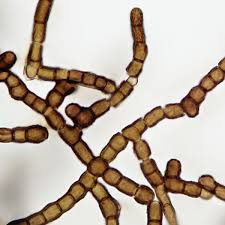What is all that black fungus in Kentucky? I’m a Pennsylvania resident and have never lived in Kentucky bourbon country, so I’ve never had to deal with the aggravation of power washing my house every year, but I have always wondered why this weird black fungus that everyone seems to take for granted as a normal, unavoidable side effect of living near whiskey warehouses has never come up in any of my whiskey history research. Surely, Pennsylvania, with all its rye whiskey history and its scores of giant bonded rye whiskey warehouses had Baudoinia compniacensis growing on them…right? But, no. I have yet to find any articles or allusions to any annoying black fungus near Pennsylvania’s distilleries. The absence of mentions doesn’t mean Pennsylvania’s distilleries weren’t plagued by the stuff, it just reinforces the fact that no one knew what caused the appearance of the black fungus to begin with. Until fairly recently, even the residents in neighborhoods near Kentucky’s distilleries had no idea what was causing their fungal blight. Some citizens believed it was caused by local gardening groups and others figured it was just pollution. Some still call it “whiskey mold” even though molds are as similar to fungi as cats are to fish. Historic references to the fungus may well be found in old agricultural journals, but they certainly wouldn’t have been connected to any distillery articles that I’ve read. So why all of a sudden is this a topic of discussion in an industry that is hundreds of years old?
Most people are now aware of the “distillery fungus” that grows near bonded warehouses in Kentucky. Lawsuits, news broadcasts, and magazine articles have done a good job of making us aware of the problem. But the fact is that there was no proof (other than common sense observation) that the fungus was in any way related to distilleries until about 16 years ago. This discovery coincided with the early years of our great American whiskey renaissance and a boom time for warehouse construction. A Canadian researcher and mycologist named James Scott was the first to recognize and publish evidence for this black fungus being connected to ethanol in 2007. Scott had been hired by the director of research for the Hiram Walker Distillery, just north of Detroit in Ontario, to investigate a pesky microorganism that other scientists had failed to identify. Locals were angrily complaining about a black soot that was causing property damage around the Hiram Walker plant. HW’s new owners, Pernod Ricard, were keen to dismiss the allegations that it might be their responsibility. James Scott’s super-geek mycology mind, however, was on a mission to crack the case…regardless of the implications! (Full disclosure: I love this part😊)
James Scott observed on arrival in Lakeshore, Ontario that the black stuff was as omnipresent as the smell coming off the warehouses. It was found to be on every surface, including stainless steel which is NOT supposed to allow microbial growth on its surface! He took samples to attempt to determine which of the 1.5-5 million possible species of fungus it could be. Scott is an old school mycologist that chooses to apply mycological taxonomy and his trusty microscope over the more modern, DNA analysis approach. He began to suss out what species he was looking at by isolating the thick-walled, barrel-shaped specimens of the fungus he found in petri dishes to grow them in a controlled environment. But the little guys just wouldn’t grow. So he decided to mix a shot of whiskey into a liter of agar (the growth substrate in the petri dishes), and to his astonishment, the samples began to grow like crazy!

What was this weird fungus? After failing to find any comparison samples that matched this “black soot”, he, like any old school researcher, dug into old archives and texts with a like-minded colleague. He found that there was an odd sample that did look the part called Torula compniacensis, but it was an unlikely candidate. As a nomenclature scientist, Scott knew that “Torula” was just a junk genus that early mycologists used when they didn’t really know what they were looking at. Torula compniacensis literally means “the Torula from Cognac.” More digging into the origins of the comparison sample showed him that its discovery was made in 1872 by a pharmacist named Antonin Baudoin, the director of the agricultural and industrial chemistry laboratory of Cognac. Baudoin had published a pamphlet on a mold blackening the walls around distilleries in Cognac. Eureka! Scott found that other researchers followed Baudoin in their recognition of the fungus in the late 1800s, but their papers all seemed to be mis-transcribed or mislabeled in one way or another. What James Scott was looking at was possibly the discovery of an entirely new genus species of fungus! This was something that was worthy of more than just a paper in mycology magazines- this was potentially a big deal! Unfortunately, the contract on his study for Pernod Ricard ran out, and he would have to continue his research elsewhere. Hiram Walker paid to have houses power washed and everyone moved on.
James Scott named the genus of the “new” fungus after the man who discovered it and kept the species name intact. Nevertheless, Baudoinia compniacensis officially became a recognized fungus in 2007. It seems that other scientists that had attempted to isolate the fungus in the past had been commingling common fungi with the mystery stuff in their samples, and when the common fungi grew faster after a couple of weeks in the petri dish, they would be covered with boring, familiar species—leading to false conclusions. Calling Baudoinia “new” is not a fair description, however, because the fungus had, in fact, been living on the planet longer than human beings! It had likely been hanging out around orchards enjoying fermented fruit, going largely unnoticed. But the evolution of modern distilleries and whiskey warehouses gave this little microorganism every opportunity to thrive- albeit a bit too well. Even more interestingly, the fungus is adapting. Scott conducted studies suggesting that the ethanol helps the fungus produce heat-shock proteins, protective against temperature extremes, which might explain how it can survive the wide range of temperatures in habitats from Cognac to Canada…to Kentucky. He’s even taken samples from locations 100 miles north of Lakeshore, Ontario. These samples showed variations in the structure of the Baudoinia with branching filaments and round, rough edges. This feisty little fungus is growing and evolving right along with the whiskey industry!
It’s a funny thing to see corporations dismiss such an interesting phenomenon. It seems research is exactly what is needed to find out more about what can be done to control this ancient microorganism. It has been said MANY MANY times that this fungus is non-threatening to people, and that is very likely the case. But it is here to stay unless the largest warehouses begin to accept that controlling the out-gassing of ethanol is going to be necessary. We like to think that the angel’s share rises up and away into the atmosphere, but alcohol is dense and prefers to stay close to the ground. Any distillery owner can tell you that escaping ethanol vapors in a distillery will stay close to the floor even if we like to imagine it rising to the ceiling. I mean, it goes up in a still, right?! But that’s not the case in the environment. Brandy distilleries in California employ thermal oxidizers to control ethanol vapors. Of course, they cost about $400,000 a piece, so it’s not inexpensive to install them in each warehouse. But should it be required when so many new warehouses are being built today? Should there be a limit placed on the size of a warehouse or should ethanol collection be made mandatory depending on how much ethanol is being put out into the environment? It may just seem like a nuisance now, but this fungus is not going to just go away without control measures put in place. Cute little towns don’t look so cute when they’re covered in black soot. It seems more research is necessary. Wouldn’t it be amazing to see this little warehouse fungus be put to work as a bio-fuel or in some other creative way? Science doesn’t have to spoil the fun of all this whiskey production! I’m interested to see what happens going forward. We can’t just power wash it all away, after all. What do you think?

